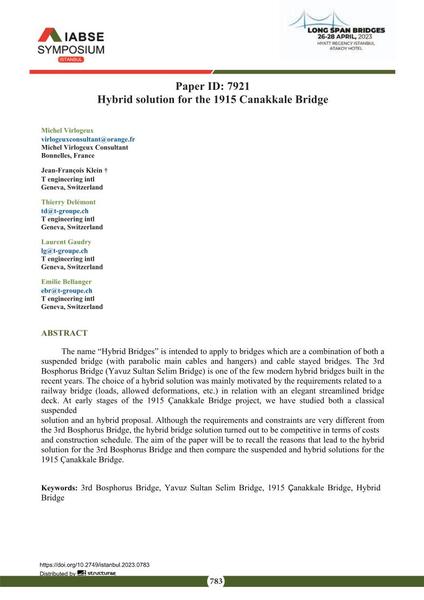Hybrid solution for the 1915 Canakkale Bridge

|
|
|||||||||||
Détails bibliographiques
| Auteur(s): |
Michel Virlogeux
(Michel Virlogeux Consultant Bonnelles, France)
Jean-François Klein (T engineering intl Geneva, Switzerland) Thierry Delémont (T engineering intl, Geneva, Switzerland) Laurent Gaudry (T engineering intl, Geneva, Switzerland) Emilie Bellanger (T engineering intl, Geneva, Switzerland) |
||||
|---|---|---|---|---|---|
| Médium: | papier de conférence | ||||
| Langue(s): | anglais | ||||
| Conférence: | IABSE Symposium: Long Span Bridges, Istanbul, Turkey, 26-28 April 2023 | ||||
| Publié dans: | IABSE Symposium Istanbul 2023 | ||||
|
|||||
| Page(s): | 783-789 | ||||
| Nombre total de pages (du PDF): | 7 | ||||
| Année: | 2023 | ||||
| DOI: | 10.2749/istanbul.2023.0783 | ||||
| Abstrait: |
The name “Hybrid Bridges” is intended to apply to bridges which are a combination of both a suspended bridge (with parabolic main cables and hangers) and cable stayed bridges. The 3rd Bosphorus Bridge (Yavuz Sultan Selim Bridge) is one of the few modern hybrid bridges built in the recent years. The choice of a hybrid solution was mainly motivated by the requirements related to a railway bridge (loads, allowed deformations, etc.) in relation with an elegant streamlined bridge deck. At early stages of the 1915 Çanakkale Bridge project, we have studied both a classical suspended solution and an hybrid proposal. Although the requirements and constraints are very different from the 3rd Bosphorus Bridge, the hybrid bridge solution turned out to be competitive in terms of costs and construction schedule. The aim of the paper will be to recall the reasons that lead to the hybrid solution for the 3rd Bosphorus Bridge and then compare the suspended and hybrid solutions for the 1915 Çanakkale Bridge. |
||||
